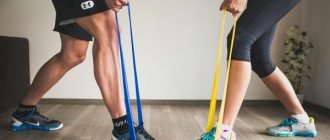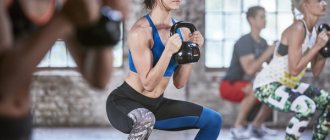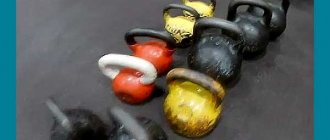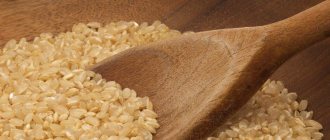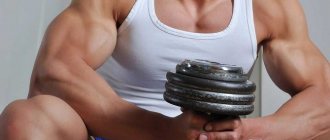Stamp of Russia Weight lifting on a silver coin of the USSR with a face value of 10 rubles, issued for the 1980 Olympics
.
- a cyclic strength sport, which is based on lifting weights as many times as possible in a given period of time in a standing position.
The governing international body is the International Union of Kettlebell Lifting[1], which unites 56 national federations (as of 2020).
The governing body in Russia is the All-Russian Kettlebell Lifting Federation (VFGS)[2]
Content
- 1. History
- 2 History of the rules
- 3 Modern rules
- 4 Exercises 4.1 Push two weights
- 4.2 Kettlebell Snatch
- 4.3 Long cycle push of two weights
- 5.1 Men. Classic biathlon.
- 11.1 Double event (weight 32 kg)
History[ | ]
Until the late 40s of the 20th century, kettlebell lifting in the modern sense, as a competition in strength endurance, did not exist. Although the weights themselves as sports equipment have been known since the end of the 17th century. Kettlebells, along with barbells and dumbbells, were used to develop physical strength or in circus performances.
On October 24, 1948, under the patronage of weightlifting specialists, the first competitions were held in which athletes exercised with two-pound weights. Although there were no official rules yet, such competitions began to be held on an ongoing basis and weightlifters saw them as a way to attract the masses to their sport.
In 1962, the first rules for kettlebell lifting competitions were developed. Since the 70s, meetings between USSR athletes have been held on an ongoing basis, and sport has also been cultivated in the Armed Forces. During that period, the rules of kettlebell lifting were constantly changing towards simplification in order to involve ever wider layers.
If bodybuilding in the USSR was not encouraged due to the fact that it took resources away from weightlifting, then kettlebell lifting was strongly approved. The only obstacle to the official recognition of this sport as an independent one was the lack of constant rules - even during one season, competitions could be held according to different rules.
Variants of the rules using the example of a jerk:
— the jerk was performed with only one hand (either) or each hand;
— it was forbidden/allowed to touch any part of the body with the weights;
— the change of hands in the snatch was carried out through a swing or through a kettlebell somersault;
— scoring was carried out either by a simple sum of both hands, or by doubling the weak hand;
— time limit in the hanging position, etc.
In 1985, kettlebell lifting received official recognition, and in 1987, the All-Union Kettlebell Lifting Federation of the USSR was created. On October 29, 1992, it was dissolved and in its place the International Kettlebell Lifting Federation was created.
Health benefits of kettlebell lifting[edit | edit code]
In the 20th century, Soviet science confirmed what Russian strongmen had known for centuries: kettlebell lifting is one of the best tools for overall physical development and provides enormous health benefits.
Voropaev (1983) observed two groups of students over several years. To evaluate their capabilities, he used standard military fitness tests: pull-ups, standing long jump, 100-meter sprint, one-kilometer race. The control group performed the usual institute program, the second group trained according to the military training program with an eye to these exercises. The experimental group only lifted weights. Despite the complete lack of specialized training, the group that only lifted weights showed the best results!
Vinogradov and Lukyanov (1986) found very high correlations between performance in kettlebell lifting competitions and a variety of other tests, including strength tests (three sets of barbells and measuring grip strength using a dynamometer), strength endurance tests (parallel bars push-ups), general endurance (running one kilometer), performance and balance (measured using special tests).
Lopatin (2000) found a positive correlation between soldiers' performance in kettlebell lifting and obstacle courses.
Kettlebells improve coordination and dexterity (Luchkin, 1947; Laputin, 1973).
Kettlebells develop professional skills in sports and improve general physical fitness (Zykov, 1986; Graban, 1990).
Kettlebells are highly effective in increasing strength[edit | edit code]
The official textbook on physical training in the Soviet army, which was approved by the Ministry of Defense (Burkov and Nikityuk, 1985), stated that kettlebells were “one of the most effective tools for increasing strength” and represented “a new era in the development of human strength potential.” .
Kettlebells are good for the heart[edit | edit code]
Siberian scientist Shevtsova (1993) proved what is obvious to any weightlifter. She followed 75 weightlifters who trained for three to five years and found that, over the long term, weightlifting helped lower heart rate and blood pressure. A weightlifter, as the Russians say, has “cosmonaut blood pressure”: 110/70 in summer and 114/74 in winter. During rest periods, the heart rate is 56 beats per minute. Not only does your heart rate drop at rest, but it also slows down during and after exercise. It also reduces the time it takes for the heart to slow down and return to its normal rhythm. In addition, experienced weightlifters quickly engage in physical activity.
Kettlebell lifting is safe if you train wisely[edit | edit code]
Only 8.8% of the best Russian kettlebell lifters, members of the Russian national team and regional teams, are injured during training or competitions (Voropaev, 1997). A surprisingly small figure, especially considering that many world-class athletes show truly inhuman results.
Kettlebell lifting improves your figure[edit | edit code]
Voropaev (1997) states: among those who trained with leading Russian kettlebell lifters, 21.2% increased their body weight from the moment they began training with kettlebells, and 21.2% (exactly the same percentage, not a typo) decreased (this is in mainly applies to overweight people). Another study of professional weight lifters showed low fat content (Gomonov, 1998).
The weightlifter is distinguished by the balanced development of all organs and muscles with noticeable hypertrophy of the muscles of the shoulder girdle (Rasskazov, 1993).
History of rules[ | ]
Initially, athletes trained in triathlon—press, clean and jerk, and snatch. The exercise lasted no more than 1-1.5 minutes and the results were very low compared to today. When the training was taken to a professional level, the results increased dramatically. For example, in 1973 in Yaroslavl, at the final competitions of the Rossovet DSO “Urozhay” championship, A. Vorotyntsev, using a push press with one hand, squeezed a two-pound weight 123 times, after which the judge stopped the exercise, not allowing the athlete to continue with the second hand. At that time, the bench press record was 42 times, and was done in the usual “power” manner. At the same time, the time for performing the exercise increased - it could reach 40-50 minutes, which is why the entertainment value sharply decreased.
To reduce competition time, the kettlebell press was removed from the program in 1982.
For the same purpose, at some competitions, rules were initially introduced prohibiting holding weights in the clean and jerk position on the chest for more than 2 seconds. But you could stay in the fixation position as long as you wanted. In the snatch, the rules prohibited the weights from touching the shoulder and chest when lowering the weights into the swing, as well as touching any part of the body with the free hand. The jerk began to be performed with each hand.
Valery Fedorenko shows a kettlebell jerk
In 1989, restrictions on the athlete being in the starting position were lifted and a 10-minute limit was introduced on performing the exercise. In the same year, competitions were held in a new discipline - long cycle clean and jerk.
Increasing strength in specific sports disciplines[edit | edit code]
Experience shows that a professionally developed general physical training program leads to improved sports results that are superior to the results of amateurs of “special” training. The reason is that specialized training cannot be effective without general physical training. And also that specific strength programs are not designed for amateurs.
A popular expression among weightlifters is the “hell effect,” which means improving things you haven’t even practiced. Powerlifter Donnie Thompson quit lifting, started kettlebell lifting, and jumped from 766 to 832 pounds in his deadlift in less than a year. Steve Knapstein, a master of kettlebell lifting, ran a marathon without training.
The amazing effect of Russian kettlebell lifting is evident in everything you train, be it deadlifts or heavy grips. To use a martial arts analogy, you will never be able to put all your force into a punch unless you work the bag.
This is a very important point. Specially developed training programs are designed for professionals. Ethan Reeve, a master of Russian kettlebell lifting, had no problem introducing kettlebell exercises to Wake Forest's highly complex training system. The same thing happened with Russian kettlebell master Mike Burgener, who developed a kettlebell training program for weightlifters.
And if you don't plan to take part in national and world championships, you don't have to go to a personal trainer. Just train according to the generalized program of Russian kettlebell lifting.
Modern rules[ | ]
Competitions in kettlebell lifting are held with weights weighing 16, 24 and 32 kg according to the double-event program: push of two weights with two hands, jerk of a weight with one and the other hand without a break for rest; or according to the long cycle program: pushing two weights with both hands from the chest, plus a short descent of the weights down, but without placing them on the platform.
A separate type of competition program is the team relay. Relay races take place in a long cycle and at a point. Usually a team consists of 5 participants, each of whom is given 3 minutes to complete the exercise. After 3 minutes, the next participant replaces him. The points scored (number of lifts) are summed up. The team that completes the most lifts wins. Detailed rules of the relay are regulated by the organizing committee of the competition. A common requirement is that all team members must be from different weight categories.
Competitions are also held in the one-kettlebell juggling program, for men and boys 16-18 years old - 16 kg, for boys 14-15 years old - 12 kg, for women, girls and boys 11-15 years old - 8 kg.
In accordance with the rules of the All-Russian Federation of Kettlebell Lifting, youth sports categories are performed with 16 kg kettlebells, adults - with 24 kg kettlebells, CMS and above - 32 kg. Women's sports categories are performed with weights of 16 kg, KMS and above - 24 kg. Men currently have 7 weight categories: up to 63, up to 68, up to 73, up to 78, up to 85, up to 95 and over 95. The categories up to 105 and over 105 have been removed from the program since 2014. For women, the categories are up to 53, up to 58, up to 63, up to 68, over 68.
Is it possible to build muscles?
To maintain balance when working in the gym after 45 years, you need to find a “golden mean”, where 50% of the exercises will be devoted to machines, and the remaining half to exercises with free weights.
Over time, a person's muscle mass decreases, because... thanks to it, protein breakdown occurs in the body, so questions about whether it is possible to build muscle if you are no longer 30 are growing in relevance. Experienced trainers give a positive answer to this and note that with the correct selection and compliance with the load, it is not difficult to give the body relief.
During training, you need to increase weight and muscle mass after 40 years according to a program selected by the trainer. To ensure that the results are not long in coming, it is recommended to follow a training and rest regime. The nervous system of those who are “for” recovers more slowly, and perceives increased workload as extraordinary stress, which is fraught with consequences. Therefore, it is recommended to go to the gym not every day, but a maximum of 3 times every 7 days if you feel well and have stable performance.
Exercises[ | ]
Push of two weights[ | ]
The athlete throws two weights on his chest (starting position), pushes them out using a squat onto fully straightened arms above his head, fixes them and, after the judge counts, takes the starting position (weights on his chest).
Does not count if:
- there is a push of the weights at the top;
- no fixation;
- there is a loss of balance;
- changing the position of the hands during the squat.
When the weights are lowered down or onto the platform, or when the weights stop on the shoulders, the exercise stops.
Kettlebell Snatch[ | ]
The athlete must, with a continuous movement, lift the weight up onto his straight arm and fix it. After the judge counts, without touching the body with the weight, the athlete lowers the weight into the backswing for the next lift. At the moment of fixation at the top, the knees and torso should be straightened and motionless, the free hand should be stopped. During the start or change of hands, an additional swing is given for acceleration.
Does not count if:
- there is contact with the body, weights or platform with the free hand;
- when pressing the weights at the top;
- no fixation;
- there is an extra swing.
If the weight stops on the shoulder or platform, the execution stops.
Long cycle push of two weights[ | ]
It is performed according to the same rules as the classic push, but before the next push-out, the weights are lowered to a hanging position, then lifted to the chest and push-out. It is allowed to lower the weights both between the legs and through the sides.
Prohibited:
- stopping the weights on the platform;
- support with hands or weights on the legs in a hanging position;
- stopping the weights in the hanging position.
Training program after 40 years for men
Fitness after 45 tones the body and is recommended for everyone who wants to improve their external and internal condition. A sample training schedule might look like this:
Tuesday
- classic squat - 3 sets of 8-12 repetitions;
- leg extension in the simulator - 2 sets of 15 repetitions;
- calf raises - 2 sets of 15 repetitions;
- bench press - 3 to 12;
- vertical row to the chest in the simulator - 3 to 12;
- dumbbell shoulder press in a seated position - 3 to 12;
- barbell curls - 3 to 12.
Thursday
- squats with a barbell in front of you - 5 sets of 20 repetitions;
- raises, sitting on toes - 2 to 12;
- dumbbell bench press on an inclined bench - 3 to 8;
- Dumbbell raises to the sides - 3 to 8;
- push-ups on parallel bars - 3 to 8;
- curls on a Scott bench - 2 to 12.
Discharge standards 2018-2021[3][4][ | ]
Men. Classic biathlon.[ | ]
The double event consists of the “jerk” and “snatch” exercises. The duration of each exercise is 10 minutes.
Points are awarded according to the rule: 1 push - 1 point, 1 jerk - 0.5 points. The table shows the number of points.
| No. | VC | Kettlebell weight 32 kg | Kettlebell weight 24 kg | Kettlebell weight 16 kg | ||||||
| MSMK | MS | KMS | Sports categories | Youth sports categories | ||||||
| I | II | III | I | II | III | |||||
| 1 | up to 48 kg | 110 | 75 | 50 | ||||||
| 2 | up to 53 kg | 120 | 85 | 55 | ||||||
| 3 | up to 58 kg | 90 | 70 | 50 | 130 | 95 | 60 | |||
| 4 | up to 63 kg | 192 | 126 | 75 | 100 | 80 | 60 | 140 | 105 | 65 |
| 5 | up to 68 kg | 210 | 146 | 83 | 110 | 90 | 65 | 150 | 110 | 70 |
| 6 | up to 73 kg | 222 | 162 | 95 | 120 | 95 | 70 | 160 | 120 | 75 |
| 7 | 73+ kg | 170 | 125 | 80 | ||||||
| 8 | up to 78 kg | 130 | 105 | 80 | ||||||
| 9 | up to 85 kg | 234 | 178 | 117 | 140 | 110 | 85 | |||
| 10 | 85+ kg | 246 | 190 | 126 | 160 | 130 | 100 | |||
Men. Push DC.[ | ]
The table shows the number of ascents in a long cycle. Time to complete the exercise is 10 minutes.
| No. | VC | Kettlebell weight 32 kg | Kettlebell weight 24 kg | Kettlebell weight 16 kg | ||||||
| MSMK | MS | KMS | Sports categories | Youth sports categories | ||||||
| I | II | III | I | II | III | |||||
| M | M | M | M | M | M | M | M | M | ||
| 1 | 48 kg | 40 | 35 | 30 | ||||||
| 2 | 53 kg | 48 | 42 | 36 | ||||||
| 3 | 58 kg | 55 | 45 | 35 | 55 | 48 | 40 | |||
| 4 | 63 kg | 59 | 44 | 35 | 60 | 49 | 39 | 61 | 51 | 42 |
| 5 | 68 kg | 72 | 56 | 45 | 65 | 54 | 43 | 66 | 56 | 46 |
| 6 | 63+ kg | |||||||||
| 7 | 73 kg | 76 | 62 | 48 | 70 | 58 | 46 | 71 | 61 | 51 |
| 8 | 73+ kg | 74 | 64 | 54 | ||||||
| 9 | 78 kg | 74 | 62 | 50 | ||||||
| 10 | 85 kg | 82 | 69 | 55 | 79 | 66 | 54 | |||
| 11 | 85+ kg | 88 | 75 | 58 | 90 | 75 | 60 | |||
Women. Dash.[ | ]
The table shows the number of lifts.
| No. | VC | Kettlebell weight 24 kg | Kettlebell weight 16 kg | |||||||
| MSMK | MS | KMS | Sports categories | Youth sports categories | ||||||
| I | II | III | I | II | III | |||||
| 1 | up to 48 kg | 80 | 60 | 45 | 43 | 33 | 23 | |||
| 2 | up to 53 kg | 90 | 70 | 50 | 45 | 35 | 25 | |||
| 3 | up to 58 kg | 100 | 80 | 60 | 55 | 45 | 35 | |||
| 4 | up to 63 kg | 159 | 126 | 73 | 110 | 90 | 70 | 65 | 55 | 45 |
| 5 | 63+ kg | 181 | 146 | 86 | 125 | 100 | 85 | 75 | 65 | 55 |
General requirements[ | ]
- MSMK is awarded for fulfilling the norm when taking 1-2 places at the World Championships,
- 1st place at the European Championships,
- 1 place at the World Cup,
- 1st place at the European Cup,
- 1st place at the world championship among juniors and juniors (19-22 years old),
- 1st place at the European Championship among juniors and juniors (19-22 years old),
- 1 place in other international sports competitions included in the Unified Calendar Plan, held according to the World Cup regulations.
- juniors, juniors 19-22 years old
Discharge standards 2014-2017 (old ones in brackets 2010-2013)[ | ]
Men. Classic biathlon.
(number of points)
Since 2020, new standards have been in force - Rank standards for kettlebell lifting 2020 - 2021.
| VC | Kettlebell weight 32 kg | Kettlebell weight 24 kg | Kettlebell weight 16 kg | ||||||
| MSMK | KMS | III | I junior | 2nd junior | III junior | ||||
| V/c 48 kg | 110 (100) | 75 (65) | 50 (40) | ||||||
| V/c 53 kg | 120 (110) | 85 (75) | 55 (45) | ||||||
| V/c 58 kg | 90 (80) | 70 (60) | 50 (40) | 130 (120) | 95 (85) | 60 (50) | |||
| V/c 63 kg | 170 (145) | 100 (95) | 70 (60) | 100 | 80 | 60 | 140 (130) | 105 (95) | 65 (55) |
| V/c 68 kg | 185 (165) | 115 (110) | 78 (70) | 110 (100) | 90 (80) | 65 (55) | 150 (140) | 110 (100) | 70 (60) |
| V/c 73 kg | 195 (180) | 130 (125) | 86 (82) | 120 (110) | 95 (85) | 70 (60) | 160 (150) | 120 (110) | 75 (65) |
| H/c +73 kg | 125 (115) | 100 (90) | 75 (65) | 170 (160) | 125 (115) | 80 (70) | |||
| V/c 78 kg | 205 (195) | 140 (135) | 97 (92) | 130 (120) | 105 (95) | 80 (70) | |||
| V/c 85 kg | 215 (205) | 150 (145) | 111 (105) | 140 (130) | 110 (100) | 85 (75) | |||
| H/c +85 kg | 145 (135) | 115 (105) | 90 (80) | ||||||
| H/c 95 kg | 223 (215) | 155 | 120 (110) | 150 (140) | 120 (110) | 95 (85) | |||
| H/c +95 kg | 230 | 160 | 126 | 160 | 130 | 100 | |||
| V/c 105 kg | 220 | 160 | 115 | 150 | 120 | 90 | |||
| H/c +105 kg | 222 | 165 | 120 | 155 | 130 | 100 | |||
Men. Long cycle push.
(number of lifts)
| VC | Kettlebell weight 32 kg | Kettlebell weight 24 kg | Kettlebell weight 16 kg | ||||||
| MSMK | MS | KMS | I | II | III | AND | II | III | |
| V/c 48 kg | 30 | 25 | 20 | ||||||
| V/c 53 kg | 38 | 32 | 26 | ||||||
| V/c 58 kg | 45 | 35 | 25 | 45 | 38 | 30 | |||
| V/c 63 kg | 48 | 37 | 28 | 50 | 39 | 29 | 51 | 41 | 32 |
| V/c 68 kg | 57 | 44 | 35 | 55 | 44 | 33 | 56 | 46 | 36 |
| V/c 73 kg | 64 | 49 | 41 | 60 | 48 | 36 | 61 | 51 | 41 |
| H/c +73 kg | 62 | 50 | 38 | 64 | 54 | 44 | |||
| V/c 78 kg | 69 | 53 | 45 | 64 | 52 | 40 | |||
| V/c 85 kg | 75 | 57 | 48 | 69 | 56 | 44 | |||
| H/c +85 kg | 73 | 59 | 46 | ||||||
| H/c 95 kg | 80 | 60 | 52 | 76 | 62 | 48 | |||
| V/c 105 kg | 82 | 62 | 55 | 80 | 65 | 50 | |||
| H/c +105 kg | 85 | 64 | 57 | 85 | 70 | 55 | |||
Women. Jerk.
(number of lifts)
| VC | Kettlebell weight 24 kg | Kettlebell weight 16 kg | ||||
| MSMK | MS | KMS | AND | II | III | |
| V/c 53 kg | 80 | 60 | 40 | |||
| V/c 58 kg | 120 | 100 | 55 | 90 | 70 | 50 |
| V/c 63 kg | 130 | 110 | 63 | 100 | 80 | 60 |
| B/c 63+ kg | 105 | 85 | 65 | |||
| V/c 68 kg | 140 | 120 | 69 | 110 | 90 | 70 |
| B/c 68+ kg | 150 | 130 | 73 | 120 | 100 | 80 |
General special conditions:
- You are given 10 minutes to complete each exercise.
- The double event consists of a “jerk” exercise and a “snatch” exercise.
- Points in biathlon are awarded: 1 push - 1 point, 1 snatch - 0.5 points.
- The sports title MS is awarded at competitions not lower than the status of the championship of the federal district of the Russian Federation, the semi-final of the Russian Championship.
- The sports category of Candidate Master of Sports is assigned at competitions not lower than the status of a constituent entity of the Russian Federation, subject to other requirements of the rules of the All-Russian Federation of Civil Society.
- The first and other mass sports categories are assigned at competitions of any status.
- Russian championships are held among juniors and junior women (19 - 22 years old), among boys and girls (14 - 18 years old).
- To participate in sports competitions, the athlete must turn the specified number of years in the calendar year of the competition.
Competitions[ | ]
Main article: World Kettlebell Lifting Championships
Main article: Russian Kettlebell Lifting Championship
In Kettlebell lifting there are two disciplines for men and one for women. Men compete in the classic double event or long cycle clean and jerk. Biathlon, in turn, consists of two exercises: a push of two weights with both hands from the chest and a snatch of one weight with each hand. In the snatch, one change of hands is allowed without placing the apparatus on the platform. After completing two exercises, points are calculated in the total of the double event. The long cycle push involves throwing the weights onto your chest, pushing up from your chest, lowering onto your chest and moving down without touching the platform. The exercise is performed with two weights.
Today, the International Union of Kettlebell Lifting[1] annually holds the World Championship, European Championship, World Junior Championship (age of participants from 18 to 22), European Junior Championship, World Junior Championship (age of participants under 18 years old) European Youth Championship. Since 2014, 5 World Cup stages and the World Cup Final have been held.
In Russia, the main kettlebell lifting tournament is the Russian Championship, which is held by the All-Russian Kettlebell Sport Federation (VFGS). The Russian Championship is held annually, participants are selected based on the results of two semi-finals.
| Year | World Championship | Europe championship |
| 2010 | Tampere, Finland | Siauliai, Lithuania |
| 2011 | New York, USA | Siauliai, Lithuania |
| 2012 | Talsi, Latvia | Belgorod, Russia |
| 2013 | Tyumen, Russia | Wexford, Ireland |
| 2014 | Hamburg, Germany | Saint-Petersburg, Russia |
| 2015 | Dublin, Ireland | Varna, Bulgaria |
| 2016 | Aktobe, Kazakhstan | Gdynia, Poland |
| 2017 | Seoul, South Korea | Daugavpils, Latvia |
| 2018 | Daugavpils, Latvia | Budapest, Hungary |
| 2019 | Novi Sad, Serbia | Stolberg, Germany |
| Year | Stage | World Cup stages |
| 2014 | 1 | Paris, France |
| 2 | Chelyabinsk, Russia | |
| 3 | Saint-Petersburg, Russia | |
| 4 | Darlington, UK | |
| 5 | Las Vegas, USA | |
| 2015 | 1 | Columbus, USA |
| 2 | Saint-Petersburg, Russia | |
| 3 | Jakarta, Indonesia | |
| 4 | Singapore | |
| 5 | Tokyo, Japan | |
| 6 | Melbourne, Australia | |
| 2016 | 1 | Cancun, Mexico |
| 2 | Saint-Petersburg, Russia | |
| 3 | Daugavpils, Latvia | |
| 4 | Tokyo, Japan | |
| 5 | Ulan-Ude, Russia | |
| Individual final | Las Vegas, USA | |
| Final com. | Sydney, Australia |
Five reasons for training with kettlebells for a bad back[edit | edit code]
1. Kettlebell lifting strengthens the buttocks
The late Vladimir Janda, MD, of the Czech Republic, noted that people with dysfunction in the back often have “gluteal amnesia.” If you do not fight this, back problems will only get worse, since the back takes on the task of lifting weights instead of powerful buttocks. And in kettlebell lifting, the buttocks are well worked out.
2. Kettlebell lifting strengthens the hip joints
According to Janda's research, buttock weakness is associated with hip joint immobility. Kettlebell lifting is the only sport that develops flexibility of the hip joints.
3. Kettlebell lifting restores mobility to the back
Professor Stuart McGill, Ph.D., the number one in the world of biomechanics, came to the surprising conclusion that developing lower back muscles does not solve back problems or develop endurance (1995). I can assure you that training with kettlebells, especially swings and snatches with high repetitions, will develop the back extensors the best.
4. “Sticking out” is better than “pulling in”
Some popular studies mistakenly recommend “pulling your belly button in” to protect your back. Dr. McGill has demonstrated that "bulging" the abdominal wall is an excellent technique. The Russian kettlebell lifting system offers many innovative techniques for strengthening the back.
5. Blast load reduces the likelihood of arthritis
The repetitive explosiveness of swings and quick lifts is incredibly good for your joints, as long as you don't overdo it. Dr. Verkhoshansky and Mel Siff say that “joints exposed to heavy training loads are less likely to develop osteoarthritis in old age and are less likely to show the characteristic signs of osteoarthritis and cartilage fibrillation... the disease progresses along the lower extremity from the ankle to the knee to the hip and finally , lumbar spine; I know that atrial fibrillation can occur at any age. It appears that regular explosive loading of the joints is mechanically much safer and allows the joints to adapt well and better withstand the high loads of running and jumping. Thus, joint cartilage after regular training remains healthy and copes well with explosive loads, while cartilage that was lightly loaded... often loses collagen, and joint density decreases.”
Federation[ | ]
Main article: International Kettlebell Lifting Union
Main article: All-Russian Kettlebell Lifting Federation
The European Kettlebell Lifting Union (EKLU) was created in 1992 on the initiative of the Baltic states. Lithuania, Latvia, Estonia, Russia, Ukraine, and Belarus took part in its work. ESGS was the first international organization in kettlebell lifting. On October 29, 1992, the International Kettlebell Lifting Federation (IFGS) was created, which included seven countries that were former republics of the USSR. The first European Kettlebell Lifting Championship took place in 1992, the first World Championship in 1993, and the first World Cup in 1994. These two structures (USGS and MFGS) worked in parallel, according to their powers. In 2007, the MFGS was dissolved, and the ESGU was reorganized into the International Kettlebell Lifting Union (IKWS) with headquarters in Latvia.
The main Russian organization is the All-Russian Kettlebell Lifting Federation (VFGS). VFGS is a member of the International Union of Kettlebell Lifting.
The International Kettlebell Lifting Union (IUKL) has been a member of TAFISA since 2009.
In 2020, an alternative federation was created, the World Kettlebell Sport Federation (WKSF)[5]. Federation President Oleg Ilica (Italy) Vice President Ivan Denisov (Russia). The 2020 WKSF World Championships took place in Italy, and in 2020 in Ireland.
There is also another federation, WAKSC, focused on club kettlebell lifting.
Turkish get up - execution technique
During the execution, you need to perform a certain sequence of movements; this exercise will require your strength, flexibility and coordination of movement.
If you're looking for an exercise that will build your body, this is it. The best definition of Turkish lifting is “kalos sthenos”, which in Greek means “beauty of strength”.
This is a powerful exercise for the whole body, by doing it you will get strong and elastic shoulders, hips and strong back muscles, and also improve coordination.
Power juggling[ | ]
A type of kettlebell lifting, rooted in circus art. It is a set of different options for throwing and catching a weight (weighing 16 kg for men and 8 kg for women) to musical accompaniment in a certain rhythm, performed by one or a group of athletes. Competitive performances of kettlebell jugglers include up to 30 throwing elements of various difficulty categories, as well as various artistic, strength, and choreographic elements that give the performance an emotional and aesthetic flavor.
World records[ | ]
Double event (weight 32 kg)[ | ]
| Weight category | Exercise | Result | Record holder | Year |
| 63 | Push | 151 | Benidze Joni | 2016 |
| Jerk | 204 | Benidze Joni | 2010 | |
| Biathlon | 234,5 | Benidze Joni | 2015 | |
| 68 | Push | 144 | Ryabkov Alexey | 2019 |
| Jerk | 192 | Shcherbin Oleg | 2019 | |
| Biathlon | 229 | Khvostov Alexander | 2014 | |
| 73 | Push | 156 | Suleymanov Movsar | 2019 |
| Jerk | 199 | Baev Konstantin | 2019 | |
| Biathlon | 250 | Suleymanov Movsar | 2019 | |
| 78 | Push | 151 | Kvashnin Mikhail | 2017 |
| Jerk | 234 | Kvashnin Mikhail | 2017 | |
| Biathlon | 255 | Kvashnin Mikhail | 2017 | |
| 85 | Push | 166 | Anasenko Anton | 2010 |
| Jerk | 208 | Anasenko Anton | 2017 | |
| Biathlon | 266 | Anasenko Anton | 2010 | |
| 95 | Push | 171 | Gurov Vladimir | 2018 |
| Jerk | 219 | Morozov Igor | 2016 | |
| Biathlon | 267,5 | Morozov Igor | 2016 | |
| 95+ | Push | 176[6] | Markov Ivan | 2018 |
| Jerk | 225 | Markov Ivan | 2018 | |
| Biathlon | 288,5[7] | Markov Ivan | 2018 |
Long cycle jerk (weight 32 kg)[ | ]
| Weight category | Result | Record holder | Year |
| 63 | 75 | Ryabkov Alexey | 2017 |
| 68 | 86[8] | Kobzar Vladimir | 2018 |
| 73 | 87 | Belyaev Ivan | 2014 |
| 78 | 88 | Chuev Pavel | 2017 |
| 85 | 94 | Chuev Pavel | 2018 |
| 95 | 95 | Balabanov Sergey | 2018 |
| 95+ | 116 | Denisov Ivan | 2010 |
Snatch - women (weight 24 kg) [ | ]
| Weight category | Result | Record holder | Year |
| 58 | 204 | Yaremenko Olga | 2018 |
| 63 | 205 | Vasilyeva Alexandra | 2019 |
| 68 | 200 | Dedyukhina Ksenia | 2014 |
| 68+ | 213[9] | Martynova Irina | 2018 |
Long cycle clean and jerk - women (weight 24 kg)
| Weight category | Result | Record holder | Year |
| 58 | 27 | Elizaveta Safronova | 2018 |
| 63 | 56 | Anastasia Lazareva | 2018 |
| 68 | 71 | Beate Karstad Stofring | 2018 |
| 68+ | 73 | Martynova Irina | 2018 |
Notes[ | ]
- ↑ 12
Russian - MSGS (Russian). www.giri-iukl.com. Retrieved January 2, 2020. - Administrator.
About VFGS
(undefined)
. vfgs.ru. Retrieved January 2, 2020. - [https://www.consultant.ru/document/cons_doc_LAW_316264/ ORDER dated November 13, 2020 N 990 ON THE APPROVAL OF A UNIFIED ALL-RUSSIAN SPORTS CLASSIFICATION (TYPES OF SPORTS NOT INCLUDED IN THE PROGRAMS OF THE OLYMPIC GAMES, OLYMPIC WINTER GAMES, AND ALSO NOT ARE MILITARY APPLIED OR SERVICE-APPLIED SPORTS)] // MINISTRY OF SPORTS OF THE RUSSIAN FEDERATION. - 2020. - November 13 (No. N 990).
- rank requirements (undefined)
. www.vfgs.ru. Retrieved February 28, 2020. - wksf (port.). wksf. Retrieved June 23, 2020.
- Girevik Online.
Ivan Markov.
Clean and jerk 176. ABSOLUTE RECORD. World Cup 2020. Daugavpils, Latvia (unspecified)
(October 18, 2018). Retrieved October 20, 2020. - WORLD CHAMPIONSHIP 2020 IN LATVIA. New records and victory of the Russian Team in the overall standings. (undefined)
. - Girevik Online.
Vladimir Kobzar.
Push DC 86 RECORD! World Cup 2020, Daugavpils (unspecified)
(October 16, 2018). Retrieved October 20, 2020. - A young Kaluga woman set a world record (Russian). nikatv.ru. Retrieved October 20, 2020.

